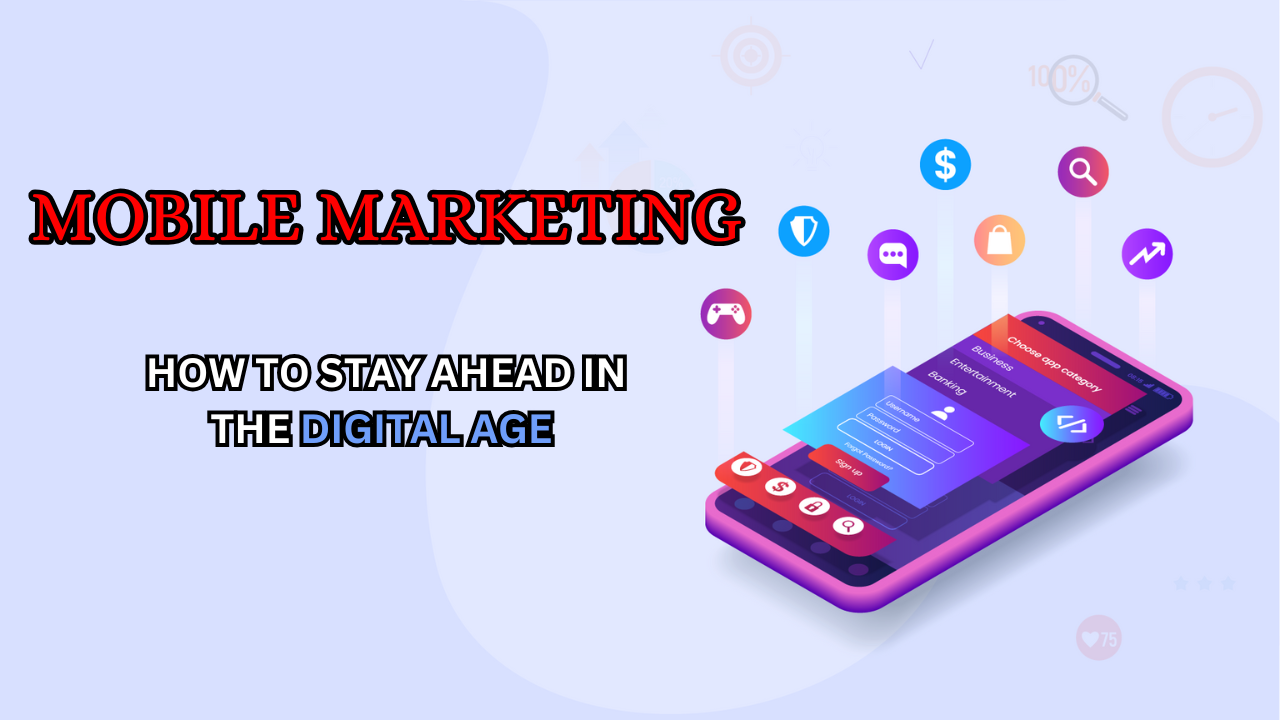In today’s fast-paced digital world, mobile marketing has become an essential strategy for reaching and engaging with your target audience. With the creation of smartphones and tablets, businesses must adapt to this trend to stay competitive. This article will explore key aspects of mobile marketing and provide practical tips for leveraging this powerful tool to boost your business.
Introduction to Mobile Marketing:
Mobile marketing involves reaching your audience through mobile devices such as smartphones and tablets. It encompasses various techniques, including website optimization, email marketing, SMS marketing, social media, and mobile apps. The goal is to create a seamless and engaging experience for users, driving customer loyalty and increasing conversions.
The Power of Smartphones and Tablets:
Smartphones and tablets have revolutionized the way we communicate, shop, and consume content. They offer numerous advantages for marketers:
- Widespread usage: With billions of users worldwide, mobile devices provide unparalleled reach.
- Convenience: Mobile devices allow users to access information and services on the go.
- Personalization: Mobile marketing enables personalized communication, enhancing the user experience.
- Engagement: Interactive features such as push notifications and multimedia messaging foster higher engagement.
Key Mobile Marketing Strategies:
1. Website Optimization for Mobile:
Ensure your website is mobile-friendly. A responsive design adjusts to different screen sizes, providing a smooth browsing experience. Mobile optimization improves load times, enhances navigation, and reduces bounce rates.
2. Email Marketing:
Email remains a powerful marketing tool. Optimize your emails for mobile by using concise subject lines, clear calls-to-action, and mobile-responsive templates. Personalization and segmentation can further boost engagement.
3. SMS and MMS Marketing:
SMS (Short Message Service) and MMS (Multimedia Messaging Service) are effective for reaching customers directly. SMS is ideal for sending short, timely messages, while MMS can include images, audio, and video. Both are great for promotions, reminders, and updates.
4. Social Media Marketing:
Social media platforms are primarily accessed via mobile devices. Leverage social media to engage with your audience, share content, and run targeted ads. Utilize features like Stories and live streaming to create dynamic and interactive experiences.
Boosting Loyalty Programs:
Mobile devices play a crucial role in enhancing loyalty programs. Mobile apps and SMS notifications can keep customers informed about rewards, special offers, and updates. Encourage users to sign up for loyalty programs and provide exclusive benefits.
Advantages of Mobile Loyalty Programs:
Real-time updates: Keep customers informed about their points balance and rewards.
- Personalized offers: Send targeted promotions based on user behavior and preferences.
- Convenience: Users can access their loyalty accounts and redeem rewards on the go.
Leveraging Push Notifications:
Push notifications are messages sent directly to users’ mobile devices from apps they have installed. They are highly effective for delivering timely and relevant information.
Benefits of Push Notifications:
- High open rates: Push notifications typically have higher open rates compared to emails.
- Instant communication: Deliver messages instantly, ensuring timely engagement.
- Personalization: Tailor notifications based on user behavior, preferences, and location.
Mobile App Marketing:
Mobile apps offer a dedicated platform for engaging with your audience. They provide a direct channel for communication, personalized experiences, and convenient access to your services.
Effective Mobile App Marketing Strategies:
App Store Optimization (ASO): Optimize your app’s listing to improve visibility and downloads.
- In-app advertising: Use ads within your app to promote products, services, or other apps.
- Push notifications: Keep users engaged with timely updates and reminders.
Mobile Gaming and Advertising:
Mobile games are a popular form of entertainment, providing opportunities for marketers to reach a diverse audience. In-game advertising allows you to display ads within mobile games, creating a seamless and engaging experience for users.
Types of In-game Advertising:
Banner ads: Display static or animated ads at the top or bottom of the game screen.
- Interstitial ads: Full-screen ads that appear at natural breaks in the game.
- Rewarded video ads: Offer users in-game rewards in exchange for watching a video ad.
Location-based Marketing:
Location-based marketing leverages the geographic location of users to deliver targeted messages. This strategy can enhance the relevance and effectiveness of your marketing efforts.
Techniques for Location-based Marketing:
- Geofencing: Set up virtual boundaries around specific locations and send notifications when users enter or exit these areas.
- Proximity marketing: Use Bluetooth or Wi-Fi to deliver targeted messages to users within a specific range.
- Location-based offers: Provide special deals and promotions based on the user’s current or past locations.
Conclusion
Mobile marketing is a powerful tool for reaching and engaging with your audience in the digital age. By leveraging the capabilities of smartphones and tablets, optimizing your website, utilizing email and SMS marketing, engaging with social media, and implementing mobile apps and location-based strategies, you can stay ahead in the competitive landscape. Embrace these techniques to create a seamless and personalized experience for your customers, driving loyalty and increasing conversions.
FAQs:
1. What is mobile marketing?
Mobile marketing involves reaching your audience through mobile devices such as smartphones and tablets, using techniques like website optimization, email marketing, SMS marketing, social media, and mobile apps.
2. How can I optimize my website for mobile devices?
Ensure your website has a responsive design that adjusts to different screen sizes, improves load times, enhances navigation, and reduces bounce rates.
3. What are the benefits of SMS and MMS marketing?
SMS is ideal for sending short, timely messages, while MMS can include images, audio, and video. Both are effective for promotions, reminders, and updates.
4. How can I use push notifications effectively?
Push notifications can deliver timely and relevant information directly to users’ mobile devices. They have high open rates, enable instant communication, and can be personalized based on user behavior and preferences.
5. What are some effective mobile app marketing strategies?
Optimize your app’s listing for better visibility, use in-app advertising, and leverage push notifications to keep users engaged with timely updates and reminders.
6. How does location-based marketing work?
Location-based marketing uses the geographic location of users to deliver targeted messages. Techniques include geofencing, proximity marketing, and location-based offers.
